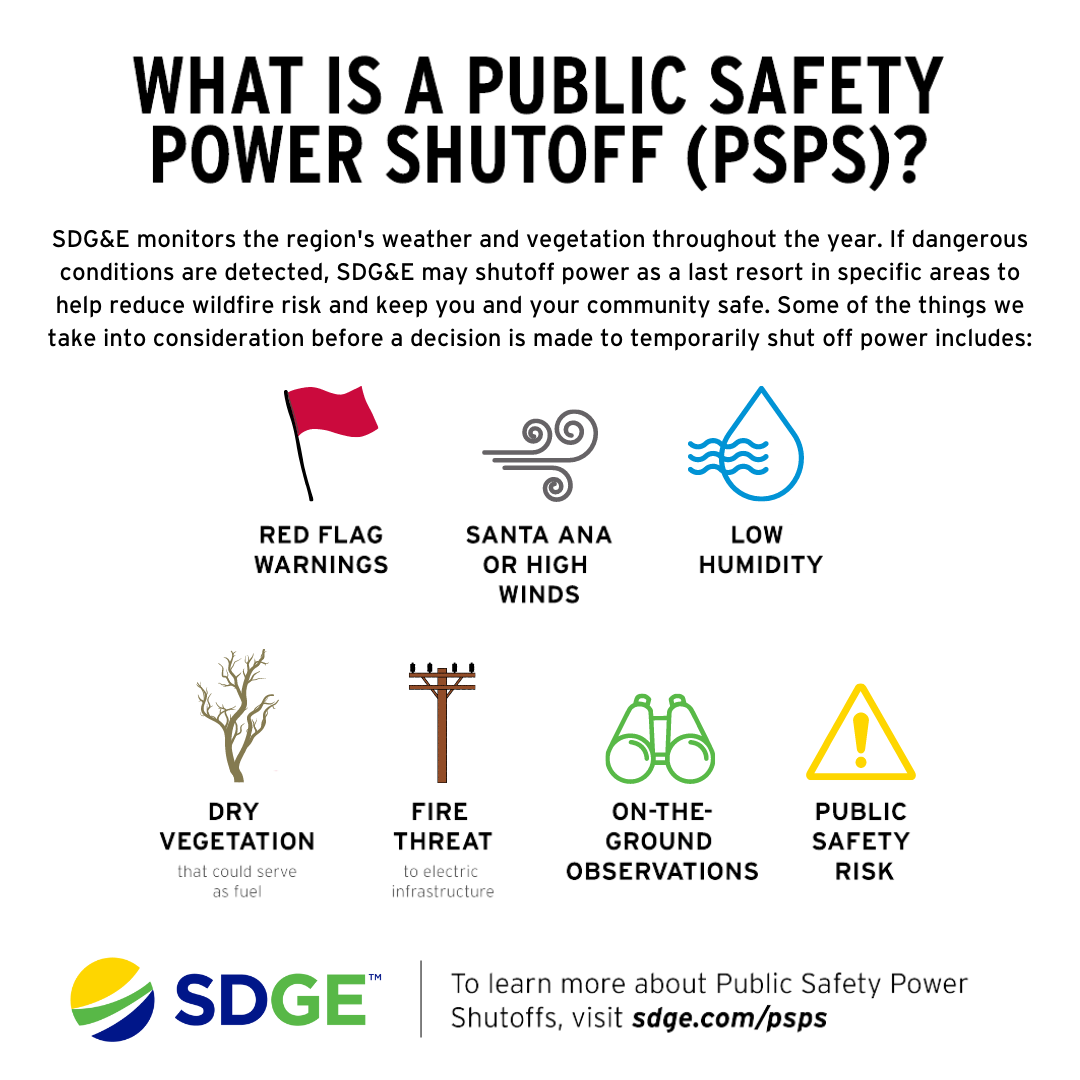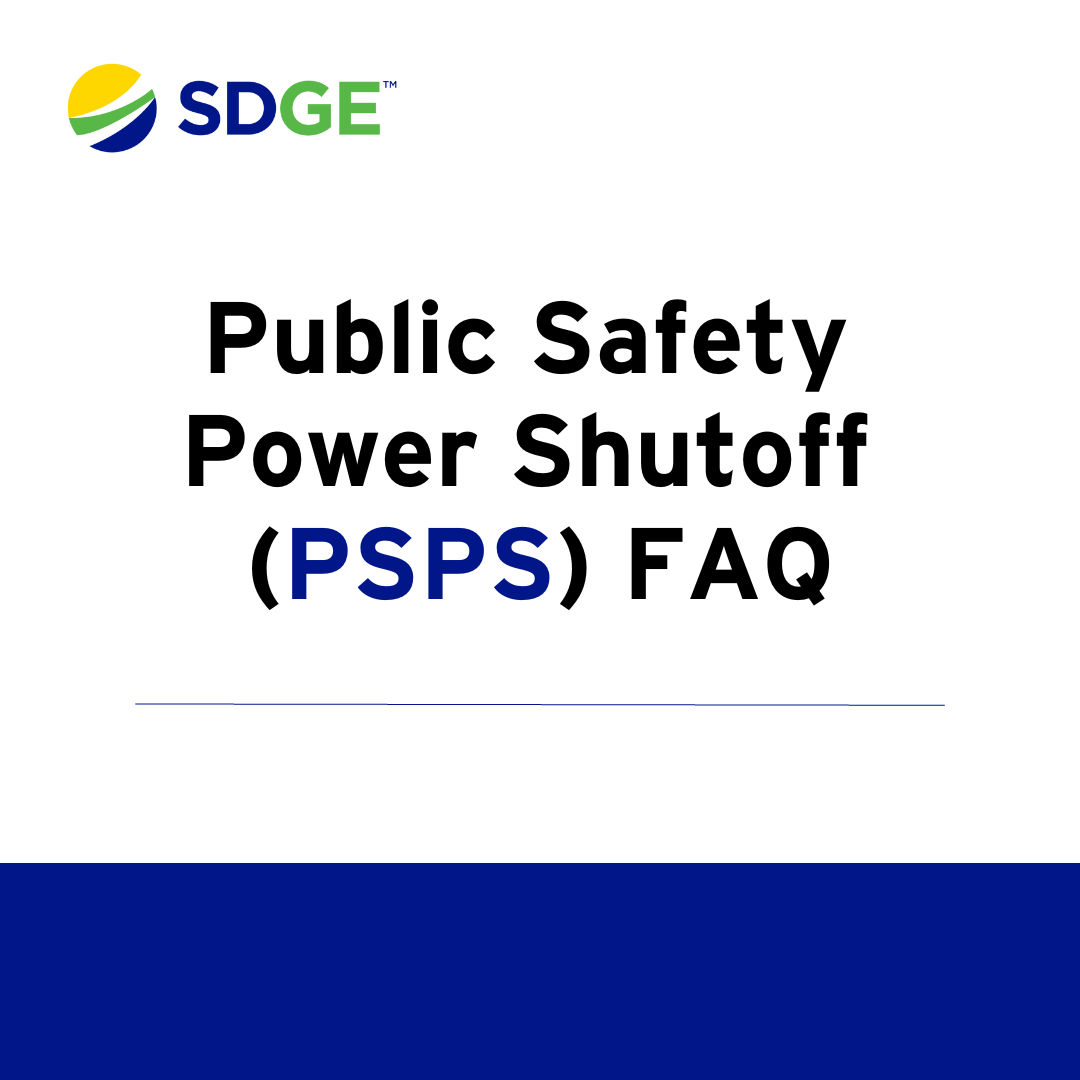
We wanted to take the time to address some commonly asked questions regarding Public Safety Power Shutoffs (PSPS). We also recommend downloading our PSPS mobile app, Alerts by SDG&E, which is a great tool to help you stay on top of information about potential and active PSPS events, including estimated restoration times.
Q: When does SDG&E shut off power?
A: We take our responsibility to operate the electric grid very seriously. If conditions threaten our ability to safely operate the system, we will turn off power to protect public safety. We take many factors into consideration before deciding to shut off power. These factors include, but are not limited to, the circumstances of the emergency, wind speed measurements, vegetation moisture, temperature, humidity, field observations by our crews and information from fire agencies.
We've developed a way to reduce the number of customers impacted when conditions may lead to a power shutoff in high-fire threat areas. Additional weather stations and electrical devices improve our ability to divide an electric circuit into smaller sections. This way, we can be more precise when shutting off power, so the number of customers impacted by a power shutoff is smaller.
Q: How long will power be out?
A: Power will remain off if the threat to our system and public safety continues — that is, as long as winds are creating a safety issue near and around our electric infrastructure. When the winds are reduced for a longer period, our crews will then patrol the lines to check for system damage from wind-blown debris or any other problems before the power is turned on.
It is difficult to predict how long a patrol might take, as it depends on the length of each power line, the terrain and whether aerial patrols are needed. Some circuits are in rural, mountainous areas that require a helicopter to patrol. In those cases, wind speeds need to be below 35 m.p.h. for the helicopter to fly safely. Additionally, for safety reasons, our crews cannot patrol at night.
Q: What is the process for restoring power?
A: It’s important to remember that improved weather conditions are not the only factor that determines whether a line is safe to re-energize. Restoring power to customers can be a long process. First, we need to record reduced wind speeds for a sustained period, then allow 4–8 hours of daylight for our field crews to patrol the line. When patrolling, crews are looking for safety hazards like downed lines, debris or tree branches caught on the line, broken hardware or issues related to communication wires. If there is any damage to the power lines or poles, repairs must be made first before power can be restored.
In the case of fire or other adverse weather conditions, this process can take days. You may see our trucks in your neighborhood as you continue to experience an outage. The information they gather helps us plan our work.
During a power shutoff, addressing hazardous situations like downed lines is a priority. Then, we work on restoring as many customers as we can, as soon as we can. We also prioritize repairs to restore service for critical needs such as hospitals, water pumping stations and police and fire departments.
Important: As we work to restore power to everyone, you may see lights on in your vicinity, while your location remains in the dark. Different parts of a neighborhood may be on different circuits, and not all circuits are restored at the same time.
Q: How can I receive updates if I don’t have cell service, or if my phone is out of power?
A: We recommend investing in a landline to ensure a stable communication channel, as well as for our crew members and first responders to reach you in an emergency. Additional solutions include purchasing a small radio with a crank or solar power to stay informed with the latest news.
Many retail outlets offer low-cost battery supply packs that should be kept charged and can provide backup charging power to your cell phone and other small electronics. Mobile devices can also be charged in a vehicle with a low-cost adapter. It is always advised to know where your local law enforcement and fire stations are located; they should have the latest information.
If you are in a high-fire threat area, there may be Community Resource Centers (CRC) available to charge small devices, or you may consider keeping a generator on hand for your home. These Community Resource centers also will have: Water, Wi-Fi, medical aid, ice, snacks, real-time information and much more. To locate a CRC near you, please click here. We hope to have CRCs available in person this year, but if COVID-19 numbers rise there is a chance they will drive-through.
Q: Does SDG&E have the authority to turn off the power to reduce the risk of wildfire during Santa Ana winds?
A: Yes. We have the authority to turn off the power in emergency situations when necessary to protect public safety. If you would like to read the resolution from the California Public Utilities Commission (CPUC) that establishes requirements for power shutoffs, click here. To read the California Public Utilities Commission’s decision confirming our statutory authority to do so, click here.
Q: Why doesn’t SDG&E design powerlines to withstand Santa Ana winds?
A: It’s important to remember that power lines from a well-maintained and well-designed power grid can still ignite a catastrophic wildfire. Over the past several years, we have made major improvements to our electric grid when it comes to wildfire preparedness. But, when dangerous fire conditions are present, it’s hard to prevent a tarp or a palm frond from whipping through 80 mph wind gusts directly into power lines, creating an ignition.
These illustrate the type of conditions that we must plan and prepare for to protect the safety of our customers. With no power flowing through power lines during windy conditions, an ignition source is removed, protecting our communities from the potential of a catastrophic wildfire.


